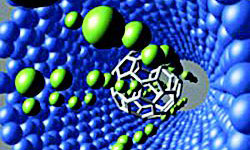Nanolithography, New Method Experienced by Iranian Scientists

Iranian researchers at the Research Institute of the Petroleum Industry (RIPI) managed to carry out lithography process by means of Atomic Force Microscope (AFM) to directly synthesize nanoparticles along with proposing a procedure for putting this method into practice.
In this method, a layer of sample is deposited on the base. By applying a force of a few nanonewtons through the device needle, a portion of sample is removed from the base surface and the desired scratch results, the Iranian Nanotechnology Initiative Council (INIC) said in a report.
The presence of contamination and the abrasion of needle are the factors limiting the repeatability of this method. One of the best solutions for this problem is to use a soft polymeric layer on the base which results in considerable improvement of the repeatability of the method and control of the process.
“In this research, we used polymethyl methacrylate for nanolithography process for the purpose of direct synthesis of nanostructures,” Sediqeh S. Hassani, one of the researchers told INIC.
“We first deposited a thin layer of polymethyl methacrylate on the surface and then did nanolithography on polymethyl methacrylate surface by means of an AFM equipped with silicon scanning probe at contact state,” she added.
The results show that the depth of scratches increases along with the increase in applied force.
The scanning speed affects the process of plan imprint so that the increase in scanning speed results in the decrease of scratches depths.
“The results of this research provide the possibility of analysis, control and measurement of force at nanoscale by AFM,” Hassani underlined.
The practical experience of this research (force measurement at nanonewton scale) provides the possibility of measuring friction and adhesion forces by means of the mentioned device and may find many applications in lubricant science, medicine, dentistry, and other related sciences.







